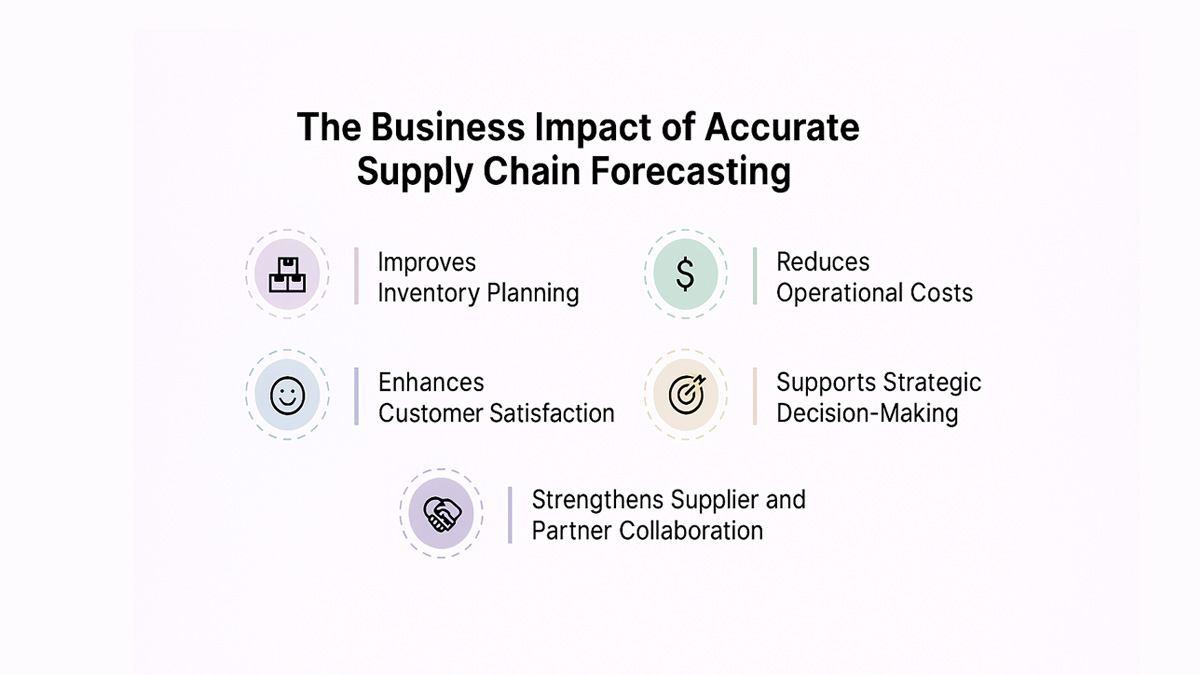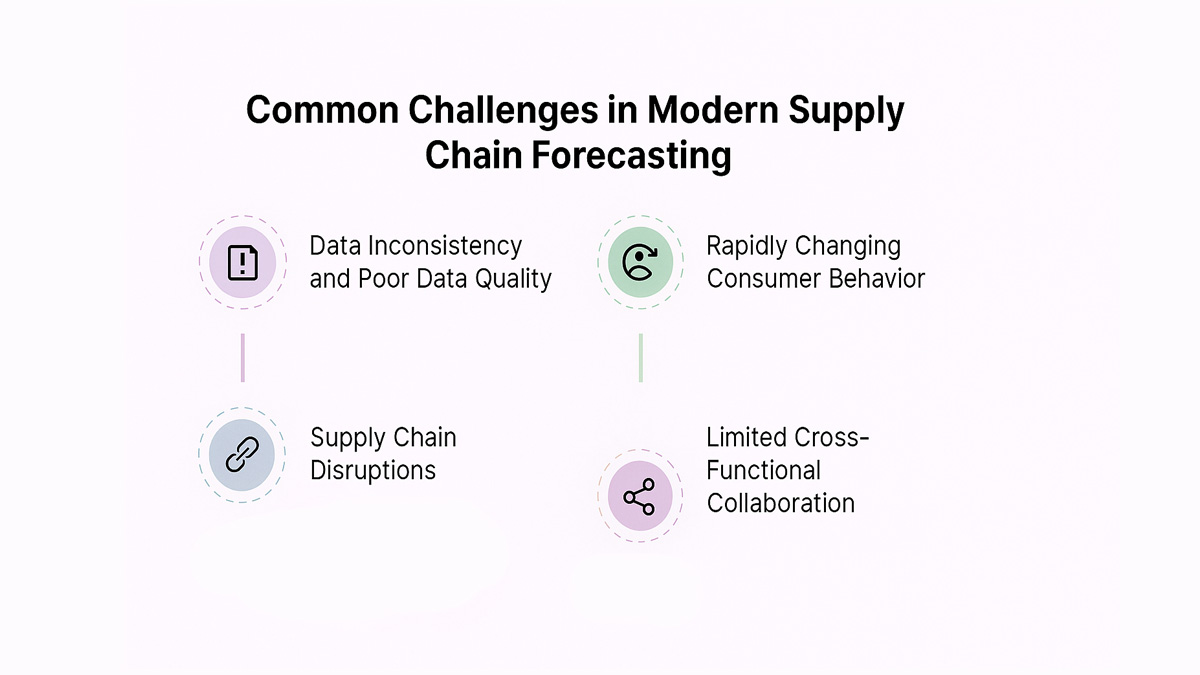

Supply Chain Forecasting 101: How to Predict, Plan, and Perform Better

Supply Chain Forecasting 101: How to Predict, Plan, and Perform Better
Explore forecasting methods, tools, and trends to improve supply chain planning, reduce risks, and optimize inventory in dynamic markets.


“Over 70% of companies say supply chain disruptions have become more frequent in the past three years,” according to a recent Deloitte report. Yet, many still struggle to predict what’s coming next.
Forecasting demand, inventory, and logistics is no longer just a planning exercise, it’s a business necessity. When done well, it helps teams cut costs, improve service levels, and adapt quickly to market shifts. But when forecasting misses the mark, it leads to stockouts, wasted inventory, and lost revenue. Getting it right can mean the difference between profit and pressure.
What is Supply Chain Forecasting?
Supply chain forecasting is the practice of predicting future demand, supply, and market trends to plan production, inventory, and distribution efficiently. It helps businesses use data and analytics to match supply with demand, cut waste, reduce risk, and make smarter operational decisions.
Why Supply Chain Forecasting is Important for Businesses
Understanding the different forecasting methods is key to choosing the right approach for your business needs. Businesses should regularly assess their forecasting techniques to stay competitive. While some rely heavily on historical data and statistical models, others draw insights from expert judgment or real-time market signals. The most effective strategies often blend multiple methods to balance accuracy with adaptability. This integrated approach improves the chances of generating accurate forecasts.

Improves Inventory Planning
Accurate forecasting ensures that companies maintain just the right amount of inventory - not too much that it ties up capital, and not too little that it causes stockouts. This plays a direct role in streamlining overall inventory management processes. It enables smarter procurement and production decisions that align with actual demand patterns. Real-time inventory tracking ensures businesses can manage just-in-time inventory effectively.
Reduces Operational Costs
Forecasting helps eliminate the inefficiencies of last-minute adjustments, emergency orders, or overproduction. By anticipating needs, businesses can schedule labor, manufacturing, and logistics more cost-effectively - leading to leaner, more efficient operations.
Enhances Customer Satisfaction
Meeting demand consistently builds trust. When products are available when and where customers want them, service levels go up. That translates to fewer lost sales, better brand perception, and stronger customer loyalty. Reliable product availability directly improves the overall customer experience.
Supports Strategic Decision-Making
Forecasting data plays a key role in long-term planning. Understanding customer demand trends also helps align planning with real-world expectations. From launching new products to entering new markets, having visibility into demand trends and supply constraints allows leadership to make informed, data-driven decisions with less guesswork.
Strengthens Supplier and Partner Collaboration
When forecasting is shared across the supply chain, it creates transparency and fosters stronger partnerships. Suppliers can plan their own operations more efficiently, reducing lead times and improving responsiveness. Better forecasting reduces strain on inventory systems and warehouse capacity.
Types of Supply Chain Forecasting Methods
Understanding the different forecasting methods is key to choosing the right approach for your business needs. While some rely heavily on historical data and statistical models, others draw insights from expert judgment or real-time market signals. The most effective strategies often blend multiple methods to balance accuracy with adaptability.
Quantitative Forecasting Methods in Supply Chain Management
Quantitative forecasting relies on data-driven techniques to predict demand, supply, and market trends. These methods use past sales records, demand fluctuations, and statistical models to estimate future performance. They’re best suited for organizations with reliable historical data and stable market conditions.
Below are five key quantitative forecasting methods used in supply chain management:
1. Exponential Smoothing
Exponential smoothing assigns higher importance to recent data while gradually reducing the weight of older information. It’s ideal for forecasting short-term demand where recent trends are more relevant than older ones. By adjusting the smoothing constant, businesses can control how quickly the forecast responds to changes in demand patterns. This method is simple, cost-effective, and widely used for operational planning in retail and manufacturing.
2. Adaptive Smoothing
Adaptive smoothing improves upon exponential smoothing by automatically adjusting the smoothing constant based on forecast errors. If demand becomes more volatile, the model reacts faster; when demand stabilizes, it slows down to prevent overcorrection. This flexibility makes adaptive smoothing especially useful in industries with frequent demand shifts, such as consumer electronics or fashion. It minimizes manual intervention while maintaining accuracy.
3. Moving Average
The moving average method calculates the average demand over a fixed period such as the last three or six months and uses it to predict future demand. As new data comes in, older data drops off, keeping the forecast current. Simple moving averages treat all periods equally, while weighted moving averages give more importance to recent data. It’s an effective choice for identifying demand trends and smoothing out short-term fluctuations.
4. Regression Analysis
Regression analysis examines the relationship between demand and one or more independent variables like price, promotions, or economic conditions to predict future outcomes. For example, a company might analyze how marketing spend influences product demand. Linear regression works best when relationships between variables are stable and measurable. This method provides deeper insight into the factors driving demand and helps refine planning accuracy.
5. Life Cycle Modeling
Life cycle modeling forecasts demand based on a product’s stage in its life cycle introduction, growth, maturity, or decline. Each phase follows unique demand patterns that can be modeled mathematically. For instance, new products often see gradual adoption followed by rapid growth before plateauing. This approach helps businesses plan production, manage inventory, and prepare for end-of-life transitions effectively.
Qualitative Forecasting Methods in Supply Chain Management
Unlike quantitative forecasting, which relies on historical data and statistics, qualitative forecasting draws from human expertise, market research, and informed judgment. It’s most valuable when reliable data is scarce or when external factors like new product launches, regulatory changes, or global disruptions make past trends less useful.
These methods help businesses make confident decisions by tapping into expert experience, customer sentiment, and market signals. Here are the main qualitative forecasting methods used in supply chain management:
1. Market Research
Market research gathers non-numerical data about customer needs, buying habits, and market trends. It helps identify what drives demand and how customers might respond to changes in price, product, or availability.
- Customer Surveys: Directly collect opinions about customer preferences and purchase intentions.
- Focus Groups: Small, moderated discussions that reveal how customers perceive a product or service.
- Competitor Analysis: Examines competitors’ strategies, pricing, and product performance to predict market shifts.
2. Delphi Method
The Delphi Method is a structured, multi-round process for gathering expert opinions anonymously. Each round refines the group’s responses until a consensus emerges.
Because it removes the influence of hierarchy or groupthink, the Delphi method is particularly useful for forecasting in uncertain or fast-changing environments such as anticipating supply disruptions, predicting technology adoption, or setting demand expectations for new products.
3. Expert Judgment and Panel Consensus
In this approach, forecasts are developed by consulting experienced professionals either individually or as a group. When experts meet to discuss potential outcomes, the result is called panel consensus.
This method leverages firsthand knowledge of markets, suppliers, and operational realities, often providing quick and practical forecasts when time is limited. It’s commonly used for short-term decisions or when aligning strategy across departments.
4. Sales Force Polling
Sales force polling collects insights directly from frontline sales teams who interact with customers daily. Their observations about shifting demand, customer sentiment, or local market activity can highlight trends before they appear in the data.
This approach works well for organizations with distributed sales networks or region-specific customer behaviors, ensuring forecasts reflect real-world market dynamics.
5. Historical Analogies
Historical analogy forecasting compares a new product’s expected demand with that of a similar past product. For example, a company launching a new smartphone model might analyze the sales curve of previous launches to estimate initial demand and peak sales periods.
This technique works best when the products or market conditions share similar characteristics, offering a practical benchmark in the absence of historical data.
6. Scenario Planning
Scenario planning creates detailed “what-if” models that imagine multiple potential futures such as supply disruptions, regulatory changes, or shifts in consumer behavior. Each scenario outlines how operations, inventory, and logistics might respond under different circumstances.
By mapping out these alternatives, companies can prepare flexible strategies to manage uncertainty and minimize risk.
Characteristics of Forecasting in Supply Chains
Effective supply chain forecasting depends on more than just data and tools. It’s defined by a few key characteristics that make forecasts practical, reliable, and adaptable to real-world conditions. The following core attributes help organizations stay prepared and make informed decisions in dynamic markets.
1. Accuracy
Accuracy is the foundation of effective forecasting. It measures how close predictions are to actual outcomes. Accurate forecasts help businesses prevent overstocking or stockouts, improve service levels, and maintain financial stability. Regularly comparing forecasted data with real results ensures continuous refinement and precision.
2. Timeliness
Timeliness ensures that forecasts are produced and updated at the right intervals. In fast-moving markets, outdated data can lead to missed opportunities or excess inventory. Timely forecasting allows teams to make proactive adjustments to production, procurement, and logistics based on the latest available information.
3. Flexibility
Flexibility allows forecasting models to adapt to sudden changes such as shifts in demand, supply disruptions, or global events. A flexible system can incorporate new data quickly and adjust assumptions without a complete overhaul. This agility helps businesses stay aligned with real-time market dynamics.
4. Scalability
Scalability refers to the forecasting system’s ability to handle growth as the business expands. As product lines, regions, or data sources increase, scalable models continue to perform efficiently. This ensures that forecasts remain accurate and actionable, regardless of company size or market complexity.
5. Adaptability
Adaptability highlights how well forecasting processes evolve with technology, new data inputs, and changing goals. As organizations adopt AI and automation, adaptable forecasting systems can integrate these tools seamlessly. This ensures continuous relevance and accuracy even as business environments transform.
6. Continuous Improvement
Continuous improvement focuses on refining forecasting processes over time. By reviewing results, analyzing errors, and learning from performance gaps, teams can improve accuracy and responsiveness. This approach builds a culture of iteration and learning where every forecast becomes more effective than the last.
How to Choose and Implement a Forecasting Method
Selecting and applying the right forecasting method is not a one-time decision, it's an ongoing process that evolves as your business grows and conditions change. The process can be divided into four key phases: Selection, Planning, Implementation, and Evaluation & Maintenance.
Phase 1: Selection (Choose the Method)
The first step is to identify your forecasting needs and choose the approach that best fits your goals and available resources.
- Identify the Problem or Goal: Clearly define what you want to achieve. Are you forecasting demand, optimizing inventory, or improving supplier performance? Write the goal in one clear sentence.
- Analyze the Current State: Understand how forecasting is currently done. Identify inefficiencies, gaps, and stakeholder pain points.
- Gather Requirements and Alternatives: Collect input from different teams and research potential methods that could solve the problem.
- Evaluate Alternatives and Feasibility: Compare your options using a pros-and-cons list or a decision matrix. Consider budget, skills, timeline, and tools.
- Select the Best Method: Choose the approach that aligns with your goals and constraints. Document why you chose it this helps with future reviews and accountability.
Phase 2: Planning (Develop the Implementation Plan)
Once you’ve chosen a method, create a detailed plan for how it will be introduced and managed.
- Design the New Process: Outline how the new forecasting process will work and who will be involved.
- Define Roles and Responsibilities: Clarify who decides, who executes, and who provides input. Use a RACI matrix to structure accountability.
- Allocate Resources: Ensure you have the people, tools, and budget required for success.
- Map Potential Risks: Identify possible roadblocks and define mitigation strategies.
- Create a Project Plan: Establish clear steps, milestones, and timelines. This roadmap keeps everyone aligned throughout the rollout.
Phase 3: Implementation
This is where planning becomes execution. Introduce the method and make sure your teams are equipped to apply it effectively.
- Communicate the Change: Explain to stakeholders why the method is being implemented and how it will improve outcomes.
- Train Users: Provide training sessions to ensure everyone understands how to use the method correctly.
- Execute the Plan: Follow your project roadmap, track progress, and document results.
- Provide Ongoing Support: Offer troubleshooting and encourage open communication during the adoption period.
Phase 4: Evaluation and Maintenance
Forecasting success requires continuous monitoring and improvement. After implementation, evaluate performance and refine as needed.
- Monitor Progress: Track key performance indicators (KPIs) to measure accuracy and efficiency.
- Gather Feedback: Regularly collect input from users and stakeholders to identify what’s working and what isn’t.
- Evaluate and Revise: Review outcomes against your goals. Identify lessons learned and document them for future reference.
- Maintain and Improve: Make small adjustments over time to keep the method effective. Forecasting should evolve with your business and market conditions.
Key Challenges in Supply Chain Forecasting Today
Even the most sophisticated forecasting models can stumble when faced with real-world volatility. From unpredictable market shifts to data quality issues, businesses often struggle to maintain consistent accuracy. Forecasting errors not only waste resources but also delay decision-making. Understanding these challenges is the first step toward building a more resilient and responsive supply chain.

Data Inconsistency and Poor Data Quality
Forecasts are only as good as the data behind them. Inaccurate, outdated, or fragmented data across systems can lead to faulty assumptions and misguided decisions. Many organizations still rely on spreadsheets or siloed platforms, making it difficult to maintain clean, real-time insights.
Rapidly Changing Consumer Behavior
Shifts in customer preferences, economic conditions, and buying patterns can throw off even the best demand models. Events like pandemics, viral trends, or market crashes often create demand spikes or slumps that historical data can’t predict. Market volatility can dramatically disrupt even the most robust models.
Supply Chain Disruptions
Natural disasters, geopolitical tensions, and global logistics issues continue to disrupt the flow of goods. These unpredictable events add noise to the data and make it harder to trust forecasts based on past performance.
Overreliance on Historical Data
While past data is helpful, it doesn’t always reflect future realities - especially in dynamic industries. Rapid market fluctuations can render historical trends unreliable. Organizations that depend too heavily on historical trends without adjusting for current context may find their forecasts lagging behind actual demand. Dynamic markets require forecasting models that can pivot quickly. Factoring in market dynamics is essential to avoid outdated assumptions.
Limited Cross-Functional Collaboration
When sales, finance, and supply chain teams operate in silos, it leads to misalignment. Forecasting works best when there’s shared input and visibility across departments - without it, assumptions go unchallenged and inconsistencies multiply. Cross-functional input often leads to more effective forecasting approaches.
Emerging Technologies Shaping Supply Chain Forecasting and Demand Modeling
As supply chains grow more complex and fast-moving, traditional forecasting tools are no longer enough. New technologies are stepping in - helping businesses make smarter, faster, and more adaptive decisions.
Artificial Intelligence and Machine Learning
AI and ML models analyze massive volumes of structured and unstructured data to uncover patterns humans might miss. Techniques like demand sensing enhance responsiveness to real-time changes. They improve over time, learning from new inputs to make increasingly accurate predictions - especially in environments with frequent change. These models adapt quickly to changing market trends, giving businesses a competitive edge.
Advanced Analytics Platforms
Modern forecasting tools now integrate real-time data from multiple sources - ERP systems, CRMs, IoT devices - and visualize it through dashboards. Predictive analytics further refines these insights by modeling future demand scenarios. These platforms empower teams to spot trends early and take action before issues escalate.
Cloud-Based Collaboration Tools
Forecasting isn’t just a numbers game - it’s a team sport. Collaborative forecasting brings together stakeholders across the value chain. Cloud platforms allow for real-time collaboration across departments and geographies, improving visibility and alignment across the entire supply chain.
Digital Twins
By creating virtual models of supply chain operations, digital twins allow businesses to simulate different scenarios and forecast outcomes. This makes it easier to test assumptions and prepare for potential supply chain disruptions.
Strategies to Improve Forecasting Accuracy
Improving forecasting accuracy isn’t about chasing perfection, it's about reducing blind spots, staying flexible, and making better data-driven decisions. The most effective strategies combine reliable data, human judgment, and ongoing refinement.
Here are key strategies to strengthen your forecasting accuracy:
- Combine Quantitative and Qualitative Methods: Blend statistical models with expert judgment. Merging historical data with feedback from sales or procurement teams captures both the numbers and the context behind them.
- Regularly Review and Update Models: Forecasting isn’t static. Revisit your models frequently to account for new data, changing market conditions, and shifts in customer behavior. Continuous updates keep forecasts relevant and reliable.
- Encourage Cross-Functional Collaboration: Involve teams from finance, operations, sales, and supply chain. Shared data and open communication help ensure everyone is working from the same assumptions and goals.
- Leverage Technology and Automation: Use AI-based forecasting tools or integrated planning platforms to analyze large datasets, detect patterns, and minimize manual errors. Automation also speeds up decision-making.
- Track Key Performance Metrics: Measure forecast accuracy using defined KPIs such as Mean Absolute Percentage Error (MAPE) and use those insights to fine-tune future forecasts.
- Incorporate Real-Time Data: Integrate data from sensors, ERP systems, or market feeds to make forecasts more responsive. Real-time visibility helps detect shifts early and act faster.
- Train Teams and Build Forecasting Skills: Regular workshops or analytics training help teams interpret data better and apply forecasting models effectively. Skilled users lead to more accurate outputs.
The Future of Supply Chain Forecasting: AI, Data, and Collaboration
The future of supply chain forecasting is driven by real-time data, intelligent systems, and stronger collaboration across teams. As technology advances, forecasting will become faster, more adaptive, and deeply integrated into everyday decision-making.
Here are some key trends shaping the future of supply chain forecasting:
- AI-Powered Forecasting: Artificial Intelligence will continue to handle complex data analysis spotting patterns, predicting demand shifts, and detecting anomalies faster than traditional models. Machine learning algorithms will refine themselves over time, improving accuracy with every cycle.
- Real-Time Data Integration: Businesses will rely on live data from IoT sensors, ERP systems, and market feeds to update forecasts continuously. This instant visibility allows faster responses to disruptions or demand surges.
- Collaborative Forecasting: Forecasting will become a shared responsibility across sales, finance, procurement, and operations. Connected data systems will create a single source of truth, enabling better alignment and decision-making.
- Human Oversight and Scenario Planning: As AI automates the heavy analysis, human teams will focus on validation, risk assessment, and what-if planning. This balance ensures forecasts remain grounded in real-world judgment.
- Agility Over Precision: The focus will shift from achieving perfect accuracy to responding quickly to change. Organizations that can adjust forecasts on the fly will have a competitive edge in volatile markets.
- Data Transparency and Shared Visibility: Cloud-based forecasting tools will promote transparency across departments, helping teams collaborate seamlessly and act on the same real-time insights.
How Spendflo Helps with Supply Chain Forecasting
Forecasting can make or break a business. When teams rely on scattered data and manual tracking, even small errors can lead to missed renewals, excess spending, or delayed decisions that ripple across the supply chain. That’s where Spendflo makes a measurable difference.
One of our clients, a fast-growing SaaS company, reduced forecasting errors by 25% within months of using Spendflo’s centralized platform. By unifying procurement, finance, and usage data, they finally had the clarity to plan budgets accurately, negotiate smarter, and move faster.
If you’re still juggling spreadsheets or disconnected systems, every delay costs more than time, it impacts cash flow, vendor relationships, and growth. Spendflo brings all your spend and contract data into one place, giving your teams real-time visibility and control over every forecasted dollar.
Forecast with confidence, not assumptions. Book a demo with Spendflo today and see how smarter forecasting starts with better visibility.
Frequently Asked Questions on Supply Chain Forecasting
What is the difference between demand forecasting and supply planning?
Demand forecasting estimates how much of a product customers will want, while supply planning determines how to meet that demand using available resources, timelines, and logistics. They work together, but focus on different parts of the supply chain puzzle.
How do companies improve the accuracy of supply chain forecasts?
They improve accuracy by combining historical data with real-time market inputs, using advanced tools like AI and machine learning, and ensuring cross-team collaboration. Regularly updating models and validating assumptions is also key.
What technologies are used in modern forecasting?
Modern forecasting relies on AI, machine learning, real-time analytics platforms, cloud-based planning tools, and digital twins - all of which enhance speed, precision, and adaptability.
Can AI fully replace human judgment in forecasting?
Not entirely. AI can process data faster and detect patterns humans might miss, but human context and strategic oversight remain essential - especially in uncertain or evolving situations.










.png)




.png)










.avif)





